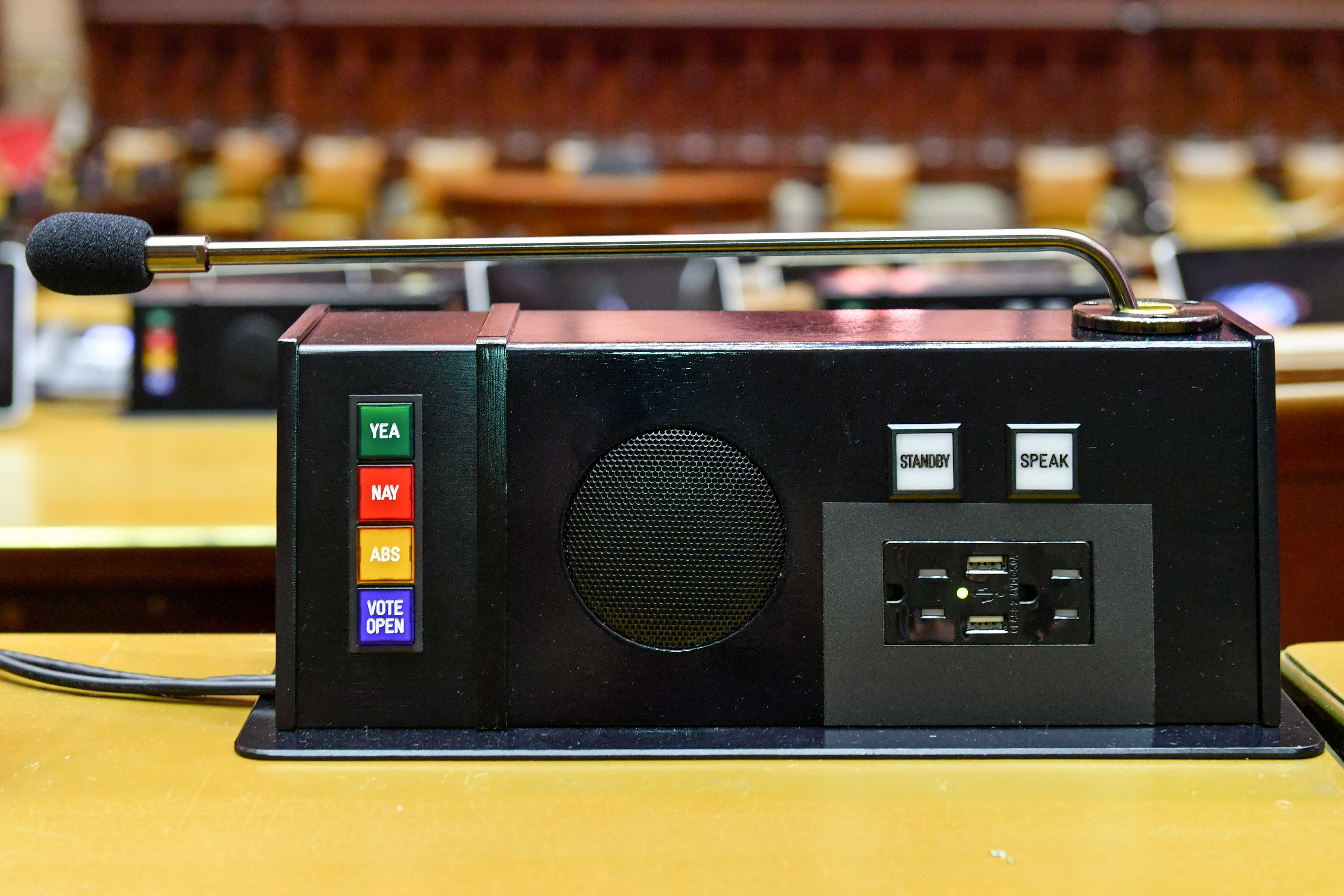The New York State Assembly recently saw the completion of a major effort to modernize its chamber and improve efficiency. In addition to replacing antiquated voting machines and telephone equipment, dramatic improvements were made to the audio capabilities to enhance speech intelligibility and facilitate better control. At the core of the audio enhancements are new multifunction voting consoles, each equipped with a custom designed microphone from Audix Corp.
International Roll-Call Corp. (IRC) of Mechanicsville, VA, which designs, fabricates, and installs legislative voting systems at the federal, state, and local level, was contracted to handle the modernization of the New York State Assembly. IRC president William C. Schaeffer described the nature of the project: “IRC worked with the New York State Assembly to craft an ideal solution for their requirements. This included implementing the latest version of our xmLegislator.NET voting software and providing new Assembly voting consoles, which feature not only voting capability but audio functions as well. Additionally, IRC designed and implemented attendance stations for members to register their presence in the chamber using proximity card technology. We also provided a new software interface to the full-color LED displays we installed previously.”

One of the greatest challenges of the New York State Assembly project was implementing the new technology without disturbing the facility’s aesthetics. The solution was to design new voting consoles that adorn each desk. As Schaeffer described, “These consoles pack a great deal of functionality into a single area on the desktop while keeping a low profile.
“Each console is about the size of a loaf of bread,” Schaeffer continued. “The enclosure and all adjoining parts are fabricated from black anodized aluminum with clear-coat. The console mounts to a plate that is attached to the Assembly member’s desk. The audio portion of each console includes switches so a delegate can request to speak, a custom-designed and custom-fabricated Audix microphone that enables one to address those in the room, and a loudspeaker for monitoring. They also provide a duplex power outlet with the added convenience of USB charging ports for phones and other personal electronic devices.”
IRC subcontracted the project’s audio system design and implementation to Code3AV of Richmond, VA. Patrick Hearring, the company’s president, described his firm’s responsibilities: “Code3AV was tasked to design a new audio system for the Assembly’s chamber. This included covering over 170 delegate desks, dais, a rear gallery, as well as a wraparound balcony. We coordinated the microphones, loudspeakers, amplifiers, and DSP mixing.”
Central to each voting console is the custom-designed Audix microphone. Hearring said, “We discovered each desk had floor boxes under them, and there was an accessible basement/crawlspace under the main chamber for pulling cable. We worked with IRC to integrate a 3-inch Fostex FE83En loudspeaker and a microphone into each voting console. The delegates stand when they speak, so a pull-up-style mic on a retractor was considered. However, management preferred a stationary mic, as they had experienced cable tangles and retractor failures in the past. We looked at many stock versions of gooseneck microphones, but due to the nature of the use, the goosenecks would fail over time, creating a continual maintenance issue.”

Hearring continued, “We wanted a mic designed for speech intelligibility that offered a durable rigid tube design, allowing the delegate to pull the mic up when they stand to speak, then lay the mic down, minimizing visual distractions, when seated. This arrangement necessitated a mic with good pickup range to acquire the voice of a standing delegate. We had used many Audix mics in the past, so I called Gene Houck, director of sales at Audix, thinking he would be open to the idea.”
According to Houck, “Although we did not have this style of microphone, we were drawn to the challenge of producing our own design for this application. This resulted in our M65 rigid tube desk microphone, which offers the durability of solid brass for both the rigid tube component and the mounting mechanism. We also designed a proprietary shock-resistant mounting flange that minimizes table sound transference. The aesthetics are enhanced by its unique black nickel plating, and the use of our high-output Micros series condenser element ensures pristine sound quality.”
Mixing and DSP for the audio system is handled by Biamp Systems’ Tesira audio/video networked media system. Among the key attributes is mix-minus functionality, which automatically mutes the loudspeaker at each delegate’s box whenever he/she begins speaking to eliminate the possibility of feedback. The Biamp Tesira Server platform operates a 180x180 matrix. The Tesira server chassis are interconnected via AVB, while each Tesira chassis is paired with an AudiaFLEX CM card chassis via CobraNet to create the mix-minus for the desk and rostrum speakers. The AudiaFLEX chassis were loaded with PA-2 amp cards to drive each desk loudspeaker.
Summing up the project’s audio challenges, Hearring reported, “The Audix mics made a world of difference on this project. The hypercardioid capsule offers 130 dB maximum SPL, plus plenty of headroom without distortion, while the swivel mount with shock protection provides quiet movement and isolation.”
Schaeffer echoed Hearring’s enthusiasm. “These mics were the perfect solution for the new voting consoles. They provide a wealth of functionality in a compact form factor that doesn’t detract from the beauty of the chamber. The New York State Assembly is very happy with the new equipment and says it has greatly increased the quality of their session proceedings—especially where audio is concerned.”